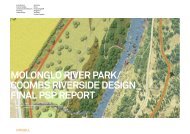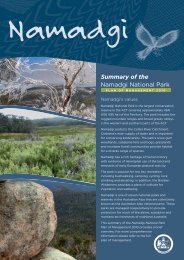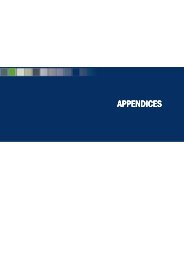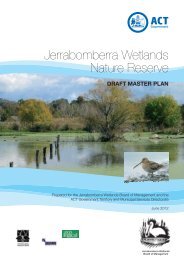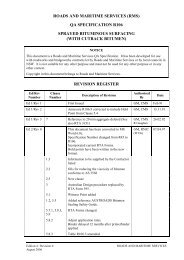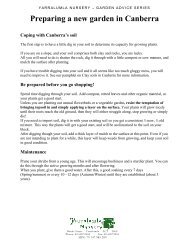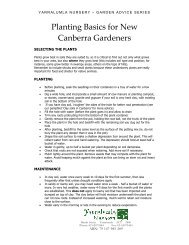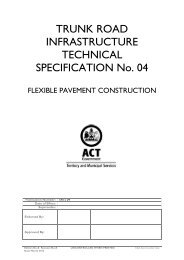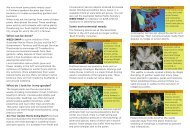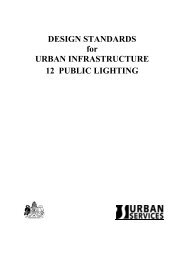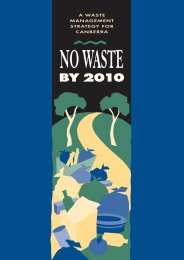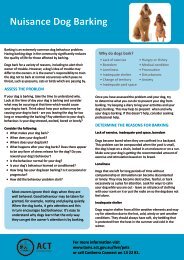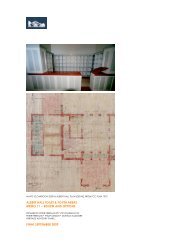Kangaroo Managment Plan - Territory and Municipal Services - ACT ...
Kangaroo Managment Plan - Territory and Municipal Services - ACT ...
Kangaroo Managment Plan - Territory and Municipal Services - ACT ...
Create successful ePaper yourself
Turn your PDF publications into a flip-book with our unique Google optimized e-Paper software.
<strong>ACT</strong> KANGAROO MANAGEMENT PLAN<br />
Historical <strong>and</strong> oral accounts described kangaroo numbers in the <strong>ACT</strong> as being in ‘plague’<br />
proportions in the latter part of the 1800s, when kangaroo <strong>and</strong> wallaby drives were carried out<br />
<strong>and</strong> states introduced bounties. There is no way of determining what these densities were. In the<br />
mid-1900s, most of the <strong>ACT</strong> was still in pastoral use <strong>and</strong> kangaroos were considered relatively<br />
uncommon due to widespread shooting to reduce perceived competition with sheep, provide<br />
food for dog packs, to reduce damage to fences <strong>and</strong> for recreation. From the 1950s, biological,<br />
cultural <strong>and</strong> economic changes reduced the need, incentive <strong>and</strong> ability of <strong>ACT</strong> graziers to<br />
control kangaroo numbers. The economic importance of rabbit fences declined rapidly after the<br />
spread of myxomatosis. There were fewer farm labourers (therefore, fewer guns <strong>and</strong> dogs), more<br />
intensive pasture improvement, rural l<strong>and</strong> withdrawals <strong>and</strong> conversion of the l<strong>and</strong> to leasehold<br />
(KAC 1996a). Sharp increases in local kangaroo populations were noticed from the 1960s to the<br />
1990s, especially in reserve areas, some of which border rural leases <strong>and</strong> provide a reservoir of<br />
animals that can move out to graze on adjacent pastures.<br />
The first credible estimate of kangaroo densities in the <strong>ACT</strong> was by prominent herbivore ecologist<br />
Graeme Caughley in 1983 who visually estimated a density of 200 kangaroos per square kilometre<br />
(2 per ha) at Tidbinbilla Nature Reserve, surprisingly close to the more rigorous later estimates. In<br />
the 1980s <strong>and</strong> 1990s, Perry <strong>and</strong> Braysher (1986) estimated kangaroo densities in reserves <strong>and</strong> on<br />
<strong>ACT</strong> rural properties for rental rebate purposes, from the density of faecal pellets.<br />
Between 1995 <strong>and</strong> 1999, line transect methods were used to estimate kangaroo densities in<br />
reserve areas <strong>and</strong> Googong Foreshores. These areas showed densities in the range from 1.9 to<br />
3.7 per hectare (190–370 per km 2 ) (Freudenberger 1996; KAC 1997; Muranyi 2000; Nelson 1996).<br />
In a survey of three reserve areas between 2001 <strong>and</strong> 2003, Fletcher (2006a) found densities in<br />
grassl<strong>and</strong>s between 4.5 <strong>and</strong> 5.1 per hectare (450–510 per km 2 ). These are among the highest<br />
recorded in Australia <strong>and</strong> compare with almost 0.56 per hectare (56 per km 2 ) for a mix of eastern<br />
grey <strong>and</strong> red kangaroos at Kinchega (Bayliss 1987) <strong>and</strong> 2.2 per hectare (220 per km 2 ) for eastern<br />
grey kangaroos at Yan Yean Reservoir, near Melbourne (Coulson et al. 1999). Relatively high<br />
densities have been recorded also in favourable environments such as in <strong>and</strong> around golf courses<br />
e.g. 3.6 to 4.1 per hectare at Anglesea, Victoria (Catanchin 2005; Inwood 2006). Inside the 1.1 km 2<br />
fenced area at Belconnen Naval Transmitting Station, kangaroo density was 5.6 per hectare before<br />
a cull undertaken in 2008. At the Majura Training Area, in May 2008, the density reached 3.3 per<br />
hectare over the whole site, including 5.3 per hectare in the grassl<strong>and</strong> section (unpublished data,<br />
Department of Defence).<br />
The densities in <strong>ACT</strong> reserves are considerably higher than on <strong>ACT</strong> rural leases where culling<br />
occurs. Between 1995 <strong>and</strong> 1997, densities of 0.39–0.59 per hectare (39–59 per km 2 ) (see Appendix<br />
5) were estimated on <strong>ACT</strong> rural leases (KAC 1997) <strong>and</strong> provided evidence in support of the<br />
arguments being put forward by rural lessees for culling. Densities on rural l<strong>and</strong> in New South<br />
Wales surrounding the <strong>ACT</strong> in 2003 <strong>and</strong> 2006, based on helicopter line transects methods, were<br />
0.12 <strong>and</strong> 0.14 kangaroos per ha (12 <strong>and</strong> 14 per km 2 ) respectively (Cairns 2004; 2007). However,<br />
helicopter line transect surveys underestimate kangaroo density compared to walked line transect<br />
surveys (Clancy et al. 1997).<br />
Examples of kangaroo density estimates for the <strong>ACT</strong> <strong>and</strong> elsewhere are shown in Appendixes 5<br />
<strong>and</strong> 6.<br />
Page 26



